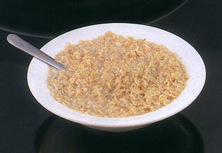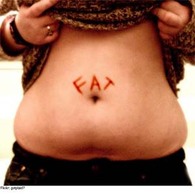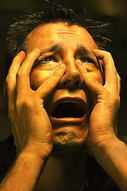Have you heard that eating more frequently increases your metabolic rate and leads to weight loss? Many scientists agree that when you eat a normal lunch your body becomes hungry three hours later. So, it makes sense that you want to have your food more frequently than 3 times a day. This is the reason why you want to snack between the meals. The problem is that the most snacks aren't healthy at all and you know it. So what to do? Well most of us try to stay away from snaking and, therefore, risk overeating at the next meal. It is catch-22. Nevertheless, according to the dieticians, a quite simple solution does exist. Eating smaller meals at three-hour intervals is believed to decrease stomach size while increasing energy levels. Doesn't it sound good? Yes, but be careful! This strategy of weight loss can only be effective if the amount ingested during each meal is small. If the portions are regular-sized meals, it can backfire and lead to weight gain. But, before you start worrying about portion sizes or meal frequency, think about two things: Do you eat breakfast? If not, it might be one of the reasons why you have excess weight. Do not skip your breakfast under any circumstances. It has been proven that eating breakfast improves your mental focus and helps to maintain a healthy weight. It is one of the two things that help to increase the metabolism rate. Those who skip breakfast tend to eat more by the end of the day.The second thing is your total daily amount of calories. Do you know how many calories you eat and how many you burn? If not, at least find out how many calories, fat and sugars are in your favorite foods. Read the packaging before you make choices. Remember: one pound of body mass represents 3,500 calories. Regardless if you are trying to lose a pound or gain a pound, the pound will always represent 3,500 calories. So, if you eat 3,500 calories more than your body requires, you will gain 1 pound. Similarly, if you eat 3,500 calories less than your body requires, you will lose 1 pound. If you'd like to start counting calories then it is good to know that an average female person can comfortably live on 1,600 – 2,000 calories a day. For men this number depends on physical activity and can be between 2,000 and 2,500 calories a day. So, now that you know you calorie maximum, you can figure out 6 meal portions. If you're new at this and need help, visit Metabolism Jolt. Metabolism Jolt is a very powerful method to give your metabolism a kick and let your body start losing excessive weight. Metabolism Jolt is a 12-day mini-meal plan that includes healthy foods organized into small portions. You will see that by having 6 meals a day you can lose weight and become healthier eater. For more information, visit MetabolismJolt.com
 Have you lost almost all the weight you wanted except for those last few pounds?
Let me guess… you are worried that your body seems to have adjusted to your new weight and you'll always be stuck 5 pounds above your ideal weight.
Don't worry, there are some things that you can do to start the scales moving in a downward direction again!
You have been doing the same exercises and eating the same foods to get you where you are now. So now, you just need a few slight adjustments to get your body back on track and out of that rut.
To do that try one or more of the following tips to help get your body back in weight loss mode.
1. If you have to eat carbohydrates, eat them before 3 p.m.
Although we need certain carbohydrates to maintain our energy levels throughout the day, we definitely have control over when we eat them.
By eating the majority of your carbohydrate servings before the late afternoon, you give your body a chance to use the carbohydrates for energy instead of being converted to fat while you are sleeping.
If you are one of those people who need a bedtime snack, try fruit accompanied by tea.
2. Add an extra day of cardio onto your workout schedule
If you can squeeze in an extra hour of cardiovascular training each week, you can overcome your weight loss plateau fairly quickly.
It doesn't necessarily mean going to the gym an extra day. Why not schedule a tennis game with your significant other, take a hike with your dog, or even go roller skating with your kids. All of these things can help you burn extra calories and have fun.
 3. Zigzag carbohydrate intake
Your body needs carbohydrates to survive, so you don't need to completely restrict carbohydrates. Try eating a lot less of carbohydrates on those days you don't go to the gym.
On the days you do workout you will need more energy, but make sure you stay within your allowed calorie intake.
4. Zigzag calorie intake
Do you eat the same number of calories every day? This can cause your metabolism to slow because your body becomes more efficient at burning the same amount of calories over time.
For instance, maybe you eat 1800 calories on the days you have a workout. On the days you don't work out, only eat 1500. By varying your calorie intake every few days, your body will keep its metabolism up and burn more calories.
 5. Change your workout routineEveryone gets into a rut sometimes, even your body. If you do the same weight training exercises or the same cardio workout each time you go to the gym, your metabolism will adjust. Instead of getting on the treadmill at the same speed for the same amount of time, try increasing the speed and incline that you use. Maybe try using a different cardio machine or walking a different route with hills. Try to mix up your overall routine a bit and you'll soon see that you've overcome your weight loss plateau. Need an inspiration? Visit MetabolismJolt.comMetabolism Jolt is a program that can help you to shake things up and reach your ideal body weight in a matter of days.
 There are many myths about healthy food selection that encourages successful weight loss. Many of them are not true.
But, there is one rule that is true for all diets:
Focusing on vegetables and fruits guarantees weight loss success. If fresh produce is unavailable, choose frozen but be sure to read labels and avoid added sugar and artificial sweeteners.
Remember:
Raw Foods must always be your fist choice before cooked foods! There is medical evidence that raw foods promote good health and cooked foods lead to the degenerative diseases and fat accumulation.
Raw foods are great for weight loss not only because you get more life force from them, but also because with their help, your body is more thoroughly hydrated and cleansed.
If your current diet is composed of mostly cooked foods and you suffer from digestive disorders, add raw foods gradually to your diet. Some people might have difficulty with sudden change of the diet.
The simplest way to add raw foods is to alter cooking methods – steam instead of cook. At first steam the veggies until they become soft. Later on, reduce steaming time so that they are eventually firm instead of soft.
Any food prepared at a temperature less than 116 degrees may be considered "raw". So, when cooking, you want to try to get close to this temperature, learn to sauté.
There are many books available at natural food stores on how to prepare tasty raw foods at low temperatures. If you don't want to go for the low temperature cooked foods, learn about weight loss methods like preparing meal replacement smoothies from fresh fruits and vegetables.
The most successful diet plan would include a mix of raw (veggies) and cooked (meats) foods.
It is highly advised to gradually stop consuming refined sugars (candy, cake, etc.) and processed starches (pasta, breads, etc.) because they are the most damaging and obstructive to the body.
Your body is comprised of millions of cells. These cells have been forced to inflate and expand in size to accommodate all the waste you've accumulated from years of poor eating.
Once the harmful foods have been eliminated completely from your diet, the body doesn't have to work on those processed ingredients anymore and immediately starts improving your cellular chemistry.
 There are a number of approaches that can lead to the weight loss. But, don't you always have to choose between eating less or eating healthy?
Here's the thing: eating less does not always lead to the weight loss! Don't think that if you live on lattes and barely ever have a meal, your body doesn't overeat.
Likewise, eating healthy does not guarantee you are going lose weight. Why? Because the meaning of "eating healthy" is different for every person.
So no, 'eating less' and 'eating healthy' do not usually bring you the weight loss result you want.
 Calorie counting, on the other hand, is the approach that gives you the opportunity to lose weight while enjoying the foods you love. Don't get scared! Calorie counting is not a rocket science – it's actually quite easy. Many dieters ignore calorie counting and end up frustrated about their weight loss results. As soon as you start paying attention to the calories it will become easy for you to determine the amount and the kind of foods you can eat and still lose weight. Weight loss is not about avoiding your favorite foods; it's about making informed decisions and eating the appropriate volume of food based on them. Here is a little tip:
Fat is extremely high in calories!Did you know that a gram of fat contains twice as many calories as a gram of carbohydrate or protein? Reduce high-fat foods in your diet, choose a low-fat option instead and you will make your first step towards successful weight loss. When you buy meat, think – protein. Fat is not naturally part of meat. Ask for lean meat. To reduce the calories you get from fat, remove the skin from chicken, cut off excess fat from lamb, pork and beef, and use minimum of cooking oil. Eat more fish, egg whites, beans and lentils – they are low-fat and a great source of protein. Milk and dairy foods such as cheese and yoghurt are an important source of calcium, protein and vitamins. Choose low-fat versions to reduce the amount of calories in your diet. Another tip:If you find it hard to count calories and want to lose weight in more convenient way, visit MetabolismJolt.com.
Did you know that you are having a wrong kind of breakfast? It could be that your weight problems start at the breakfast table.
Remember the saying, "Breakfast is the most important meal of the day?" While it is true in many ways, the most important fact to realize is that breakfast may help control increasing problem with overweight and obesity.
Do you eat the same breakfast every day? What is it?
After fasting all night breakfast is meant to kick-start your energy level. Eating the right kind of breakfast increases the metabolic- or calorie-burning - rate. Consequently, you have more energy and weight control is easier.  Is your breakfast a kicker?
Let's find out.
Do you feed on the foods heavy with refined sugars, like pastries and sugary cereals? These foods a full of empty calories and lack many essential nutrients. High sugar foods (and drinks) may give you instant energy but after a short while you will feel drained and hungry, even if you ate your breakfast.
Does it sound familiar? If yes, then just stop until you try the right kind of breakfast.
Here is what you need to go for to avoid the sugar slump
Choose whole grain breads and fresh fruits and even foods that are not usually served for breakfast, such as vegetable soup or a bean spread like hummus on whole wheat toast. These foods will give you longer-lasting energy and you will have a steady energy level till lunch.
Remember: What you choose to eat for breakfast makes a big difference for your weight!
There is one trick you should know and use to make breakfast help you lose weight throughout the day.
Listen up:
A number of studies confirm that people who successfully maintain a significant weight loss eat protein for breakfast. Research shows that starting your day with a high-protein breakfast can enhance weight loss by pushing your metabolism and curbing your appetite at later meals.
Did you know that a protein-rich breakfast has the power to force your body to use your fat cells to supply you with the energy for up to 3 hours? This very a important piece of information! It's almost like going to the gym first thing in the morning.
Why does it happen? According to Dr. OZ (we all know from the TV) protein consumed in the morning boosts your metabolic rate by 25%. Your metabolism needs a little push to burn fat, so what you have to do is to make sure you eat or drink protein during the first 30 minutes after you wake up.
The best way to feed your body protein is to drink a protein shake or to mix protein powder with a low-fat yogurt.
If you want to lose a couple of pounds, you don't need to change much in your diet – just change the breakfast. You lose weight when you burn more calories than you consume during the day.
For breakfast to support this goal, it must be relatively low-calorie and still satisfying enough to fill you up until lunch. Protein is low-calorie.
Have your protein first thing in the morning, then make yourself a nice cup of green tea and have a whole-grain toast, egg whites omelet and a fresh fruit of your choice. This kind of breakfast might be enough to support any weight loss goal.
|







 RSS Feed
RSS Feed